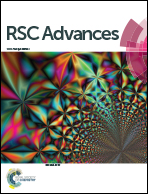Evaluating Prussian blue analogues M II3[MIII(CN)6]2 (MII = Co, Cu, Fe, Mn, Ni; MIII = Co, Fe) as activators for peroxymonosulfate in water†
Abstract
[Fe(CN)6] and [Co(CN)6]-based Prussian blue analogues (PBAs) were prepared with various metal ions (i.e., Co, Cu, Fe, Mn and Ni) and evaluated as catalysts to activate an important oxidant, peroxymonosulfate (PMS). Decolorization of Rhodamine B (RhB) was selected a model test for evaluating PMS activation. Co and Mn-containing PBAs were capable of activating PMS while Cu, Fe and Ni-containing PBAs were unable to activate PMS for decolorization. As Co3[Fe(CN)6]2 (Co–Fe) and Co3[Co(CN)6]2 (Co–Co) appeared to be the most effective PBAs for activating PMS, factors influencing RhB decolorization were further investigated to examine PMS activation by Co–Fe and Co–Co under various conditions, including changes of PBA loading, PMS dosage, temperature, pH, and salt. Both Co–Fe and Co–Co exhibited much higher catalytic activities than Co3O4 for activating PMS to decolorize RhB in water, revealing the promising catalytic activity of Co-containing PBAs. Co–Fe and Co–Co were preferably used to activate PMS at elevated temperatures and under neutral conditions. Co–Fe and Co–Co also remained highly effective for activing PMS even in the presence of concentrated NaCl. Effects of radical scavengers on decolorization suggest that RhB decolorization using PMS activated by Co–Fe and Co–Co both primarily involved sulfate radicals and hydroxyl radicals to a lesser extent. Recyclability of both Co–Fe and Co–Co were stable and effective for activating PMS over multiple cycles. These findings reveal that Co-containing PBAs are the most efficient PBAs for activating PMS and can be promising catalysts of PMS activation for degrading organic pollutants.
![Graphical abstract: Evaluating Prussian blue analogues MII3[MIII(CN)6]2 (MII = Co, Cu, Fe, Mn, Ni; MIII = Co, Fe) as activators for peroxymonosulfate in water](/en/Image/Get?imageInfo.ImageType=GA&imageInfo.ImageIdentifier.ManuscriptID=C6RA16011E&imageInfo.ImageIdentifier.Year=2016)

 Please wait while we load your content...
Please wait while we load your content...